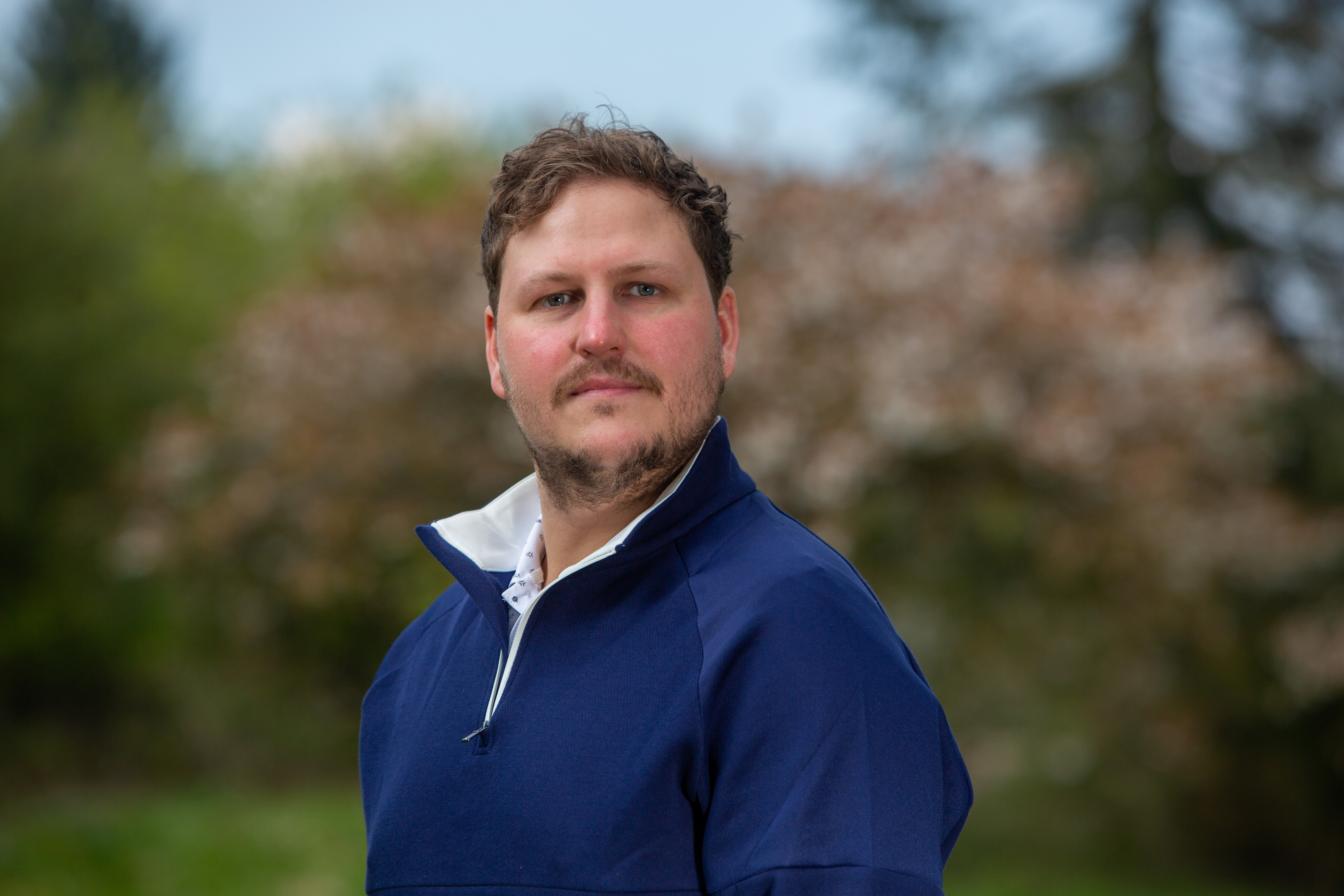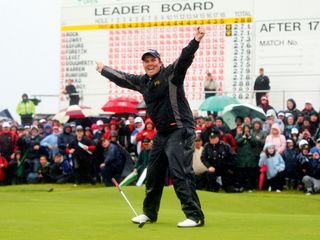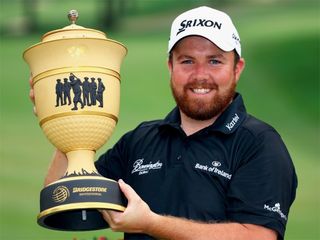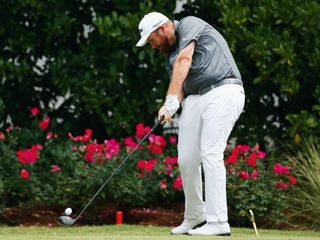Shane Lowry: hitting the big time


Shane Lowry's career hit new heights with his triumph at the WGC-Bridgestone Invitational. He talks to Neil Tappin about his impressive rise up the rankings
It’s 8.30am on the Monday morning of BMW PGA Championship week at Wentworth, and I’m sat with Shane Lowry in the clubhouse at nearby Bearwood Lakes. Our interview is due to take place on the golf course, but it’s hammering down with rain outside so we’ve retreated to the safety of the boardroom.
Having started his season on the PGA Tour, this is the Irishman’s first tournament back on European soil – little does he know what the next few months have in store.
Exactly six years ago, in similarly wet and windy conditions, Lowry became only the third amateur to win on the European Tour. By defeating Robert Rock in a play-off at the Irish Open, his first professional event, he leapt from promising amateur to star of the game all in the space of four magical days.
So spectacular was the achievement that Golf Monthly went in search of an in-depth interview with the man himself. The opportunity arrived in September of 2009 and I was dispatched to his home in Offaly, where Shane was still living with his parents.
With a souvenir caddie’s bib from the Bridgestone Invitational he’d recently returned from on the wall of his bedroom and a poster of him holding aloft the Irish Open trophy above the garage door, this was a family still revelling in their son’s astonishing success. The shock of that win and the career trajectory it sparked was still sinking in. It was great to see.

Returning to the present day, it seems fitting to start our conversation by reflecting on that time in his life. Six years on, and with the experience to place that triumph into context, I wonder how big the achievement seems now…
Get the Golf Monthly Newsletter
Subscribe to the Golf Monthly newsletter to stay up to date with all the latest tour news, equipment news, reviews, head-to-heads and buyer’s guides from our team of experienced experts.
“I’d have good money on it never happening again!” he says. “If you told me an amateur was going to win on tour this week I’d laugh. It’s so hard to win as a pro, never mind to come along in your first tournament as an amateur and do it. I just played great that week, everything went for me.”
This immediately reminds me of one of the things I liked about Shane from that initial meeting – his laid-back, ‘what you see is what you get’ character. He’s a long way from the identikit, highly polished, media-savvy sports star we see so often these days.
Instead, if you ask him a question, he’ll give you an answer – no heirs, no graces and certainly no worries about how he might be perceived. But I’m interested in whether the grind of professional golf has worn him down. Has he become more guarded with age, more circumspect with his answers?
“Us professional golfers get a little bit precious over time,” he says. “ But I like to think I’m just the same fella. I’ve got the same group of friends back home. I just think I’m a normal lad who happens to be good at golf. A lot of my friends back home don’t even play golf. I’d like to think I’m the same relaxed fella who won the Irish Open six years ago. Obviously, I’ve changed a little bit… I’m six years older so I’d like to think I’m wiser!”
While he might resemble the same man off the course, Shane Lowry has undoubtedly transformed himself on it. Winning the 2009 Irish Open allowed him to jump-start his professional career by taking advantage of the playing privileges afforded to him.
But Lowry was far from the finished article. This meant that instead of completing his apprenticeship at elite amateur level, he would do so while competing against the best players in the world, under the glare of an expectant media.
As far as learning curves go, this was a steep one, and the Shane Lowry we see today moving steadily towards ‘world-class’ status is the product of those tough early experiences.
Related: Shane Lowry - effective practice
“Playing professional golf week in, week out you learn a lot,” he explains. “You learn to be more consistent, you learn to be clever. You learn to aim away from flags and that’s actually quite difficult for me, to take pars and bogeys when you’re out of position. Professional golf is all about just ticking along and taking your birdies when you can. If you can make four or five birdies a day and try and limit your mistakes you’re going to be up there at the end of the week.
“People think that top amateurs are straight away going to be good enough to play on tour, but it doesn’t work like that. It’s a tough school out here.
“I’m a much better golfer now. For a start I’m about 30 yards longer. When I came out on tour, my 7-iron went 170 yards and it goes 180 now. My driver through the air was carrying probably 265 to 270 yards, now it’s 290, so I’m a lot longer. I just think everything has improved. It’s from being on tour, playing great golf courses, being on great practice facilities with perfect conditions.”
Listening to Lowry talk about his own development, it’s hard not to be struck by his confidence. But this is as far from arrogance or bravado as you could get from a top-level sportsman. If you look at the Irishman’s results, the upward trend is there to back it up.
In 2014, he finished tenth on the Race to Dubai, earning €1.7 million in the process. This year, having split his schedule between Europe and the US, he has registered six top 20s in 12 events (at the time of writing).
Of course, this includes his triumph at the WGC-Bridgestone Invitational and a tie for 9th in the US Open at Chambers Bay, where he played with the pressure of Major contention for the first time.

On a US Open layout that tip-toed precariously along the fine line between challenging and ridiculous, Lowry showed the mental strength and golfing skill to hang around. He finished alongside his friend Rory McIlroy as the highest-placed European.
This was just the start. His win a few weeks later in Akron was the breakthrough his career stats were hinting at. By holding off the likes of Bubba Watson, Justin Rose and Jim Furyk, Lowry announced himself to the American golfing public in particular.
And what they saw, both at the US Open and the Bridgestone, was a chipping game that has become the envy of many on tour. The relaxed rhythm with which he chips has made his short game one of the very best.
“I grew up playing golf on a course called Esker Hills. It’s in the middle of Ireland and it’s not that well known,” he explains. “I think the reason my short game is quite good is that all the greens there are raised. You’d always have to chip it up with a little bit of spin. I was never taught how to play them but I chipped and I chipped and over time I developed it.”
A closer look at his PGA Tour stats reveals that far from propping up the rest of his game, Lowry’s chipping is part of a set of solid skills: he averages 297 yards off the tee, 66% of greens in regulation and 95% of up and downs from just off the green. This has helped him achieve a scoring average of 70 – not bad for your first year Stateside.
Rising star
Since our interview on that wet and windy day in Berkshire, Shane’s stock within the game has risen rapidly. He has jumped 29 places in the world rankings to number 19, has a full PGA Tour card to his name and has unlocked the door to play in the biggest tournaments in the game for the foreseeable future. And if that wasn’t enough, his bank balance is a whopping £1.2 million pounds better off.
The cherry on the cake, however, is still to come. By winning the Bridgestone, Lowry has taken a giant leap towards his ultimate goal at the time of our meeting.
“I heard Rory at the end of last year wrote his goals down on the back of a boarding pass and put it into his wallet,” Lowry said. “I don’t really set goals but the next Ryder Cup team is a big target for me. From August, September this year that’s my main focus. I feel like I need to get myself well inside the top 50 in the world and I feel like I need to go and compete at the big events. That’s there for me, there for the taking.
“I think the next Ryder Cup is going to be massive for Europe. I’d love to be on that team. I love competing in the big events so I can only imagine how good it would be playing in the Ryder Cup.”

Lowry is of course far closer to making Darren Clarke’s team for Hazeltine now than when we met for our interview. His World Golf Championship win was an achievement even the man himself would have struggled to see coming.
Having studied his stats and followed his career progression, however, I wondered whether Lowry was getting the recognition he deserved. He was on the cusp of reaching the top but seemed to be flying under the radar. When I asked him whether he was underrated, his response, with the benefit of hindsight, was rather revealing.
“I’ve only won twice in six years,” he said. “I know for a fact I can go up against any golfer in the world and beat them, that’s how I feel, no matter who it is. I’m very confident in my own ability. I don’t know what other people think of me. As regards to underrated, I’m not sure I’ve done enough to not be underrated. I feel that going into the final round of an event, if I was up there with five of the best golfers in the world, I would be the underrated guy, but I’d be confident in my own ability.”
When Shane Lowry won the 2009 Irish Open he was hailed as a special talent. A world star in the making. The freedom with which he played under the unfamiliar pressure of a Sunday on tour is something very few are blessed with at the start of their career.
Since then, his progress has been steady if relatively unspectacular. Over the last six years, he’s travelled Europe and the world, gradually developing his game every step of the way.
Now, aged 28, the big breakthrough has finally come. What’s more, with the tournament schedule of a world top-20 player to look forward to, his future looks even brighter.
Photography: Getty Images

Nick Bonfield joined Golf Monthly in 2012 after graduating from Exeter University and earning an NCTJ-accredited journalism diploma from News Associates in Wimbledon. He is responsible for managing production of the magazine, sub-editing, writing, commissioning and coordinating all features across print and online. Most of his online work is opinion-based and typically centres around the Majors and significant events in the global golfing calendar. Nick has been an avid golf fan since the age of ten and became obsessed with the professional game after watching Mike Weir and Shaun Micheel win The Masters and PGA Championship respectively in 2003. In his time with Golf Monthly, he's interviewed the likes of Rory McIlroy, Justin Rose, Jose Maria Olazabal, Henrik Stenson, Padraig Harrington, Lee Westwood and Billy Horschel and has ghost-written columns for Westwood, Wayne Riley, Matthew Southgate, Chris Wood and Eddie Pepperell. Nick is a 12-handicap golfer and his favourite courses include Old Head, Sunningdale New, Penha Longha, Valderrama and Bearwood Lakes. If you have a feature pitch for Nick, please email nick.bonfield@futurenet.com with 'Pitch' in the subject line. Nick is currently playing: Driver: TaylorMade M1 Fairway wood: TaylorMade RBZ Stage 2 Hybrid: Ping Crossover Irons (4-9): Nike Vapor Speed Wedges: Cleveland CBX Full Face, 56˚, Titleist Vokey SM4, 60˚ Putter: testing in progress! Ball: TaylorMade TP5x
-
 I've Played Both World-Class Links And Delightful Hidden Secrets Along Ireland's Wild Atlantic Way...
I've Played Both World-Class Links And Delightful Hidden Secrets Along Ireland's Wild Atlantic Way...Kevin Markham highlights the golfing adventure that is west Ireland's spectacular Wild Atlantic Way
By Kevin Markham Published
-
 Brandon Stone Facts: 10 Things To Know About The DP World Tour Pro
Brandon Stone Facts: 10 Things To Know About The DP World Tour ProThe South African golfer enjoyed a successful amateur career before turning pro – here are 10 things to know about the DP World Tour star
By Mike Hall Published